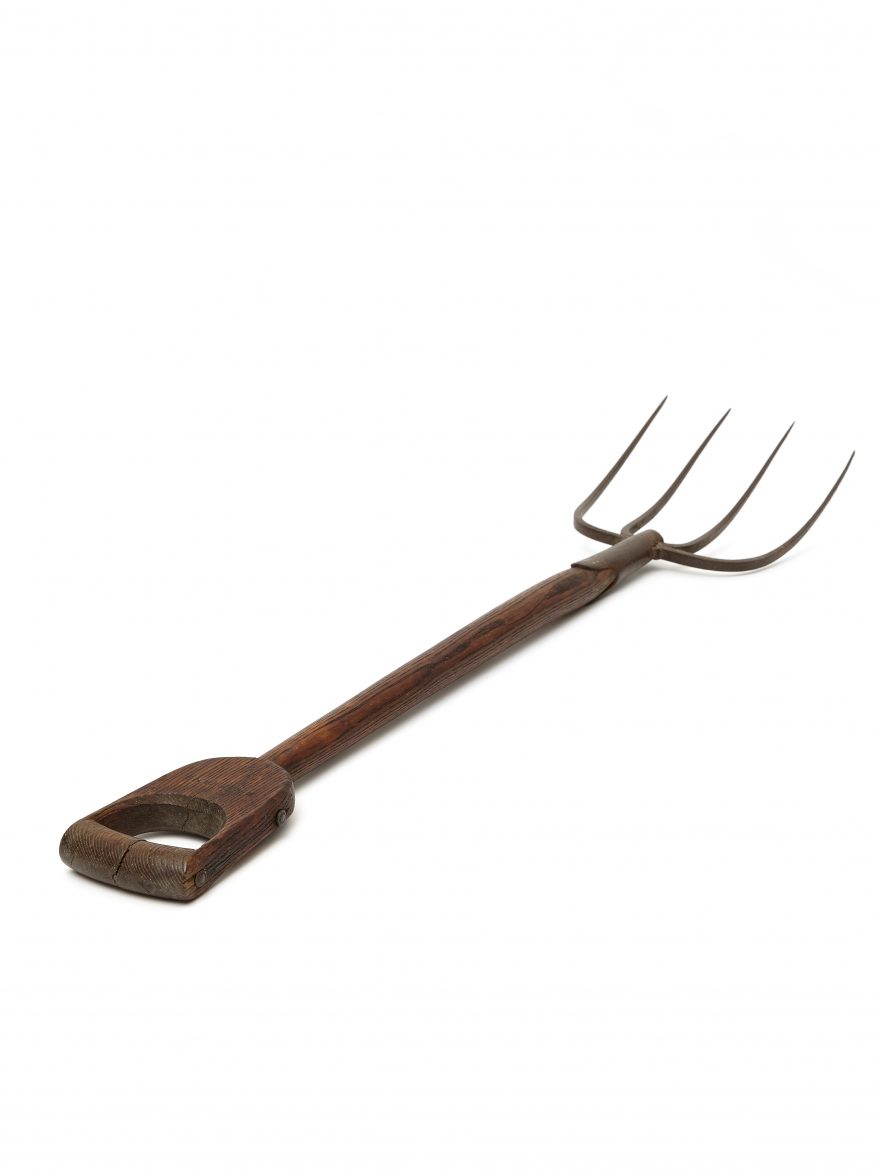
Garden Fork, North Family, Mount Lebanon, New York, ca. 1870, Shaker Museum | Mount Lebanon, 1950.3201.1. Photograph by Matthew Kroening.
In 1948, several months after the Shakers left their Mount Lebanon home and moved in with the Hancock Shakers but before they sold off their property, Phelps Clawson, the first curator of Shaker Museum | Mount Lebanon founder John S. Williams’s Shaker collection, found this garden fork in the foundation of a ruined building at […]

Garden Fork, North Family, Mount Lebanon, New York, ca. 1870, Shaker Museum | Mount Lebanon, 1950.3201.1. Photograph by Matthew Kroening.
In 1948, several months after the Shakers left their Mount Lebanon home and moved in with the Hancock Shakers but before they sold off their property, Phelps Clawson, the first curator of Shaker Museum | Mount Lebanon founder John S. Williams’s Shaker collection, found this garden fork in the foundation of a ruined building at the North Family. The building in which he found the fork was most likely, and appropriately, the Farmers’ Tool House that stood from 1860 to 1948 between the west end of the 1859 Great Stone Barn and the 1853 Wagon Shed (called the Garden House by the Shakers). The fork, with a small break in the handle just above the tines, may have been left behind as no longer useful. Break or no break, the fork does have the name “F.W. Evans” branded into its handle, making it a treasure to this institution.

Elder Frederick William Evans, North Family, Mount Lebanon, New York, ca. 1878, Shaker Museum | Mount Lebanon, 2013.23524.1. W. G. C. Kimball, photographer.
Frederick William Evans (1808-1893) was the North Family elder from 1858 until his death. He very well may have been the most widely know Shaker ever – mostly through his writings, public sermons and lectures, and as the head of the North Family. This family was the “gathering or novitiate” order at Mount Lebanon, the Shakers’ largest community. As the novitiate family, it was the primary conduit between the Shaker and non-Shaker world. Members of the press, photographers, foreign dignitaries, and the masses of curious travelers on the road would be directed to the North Family for information about Shaker life and belief. Evans would often be the person with whom they spoke. Elder Frederick was well known in his Shaker world as a farmer – journals often place him in gardens and orchards, experimenting with improvements to maximize yield and defend against natural threats to the family food supply. He was particularly interested in composting and natural fertilizers and the introduction of the use of ensilage to feed the family’s stock. It was probably Elder Frederick who designed the Great Stone Barn, and who controversially tried to turn the North Family into the kind of English gentleman’s farm on which he had spent his youth.

Garden Fork (detail of forged tines and cast iron collar), North Family, Mount Lebanon, New York, ca. 1870, Shaker Museum | Mount Lebanon, 1950.3201.1

Garden Fork (detail of handle), North Family, Mount Lebanon, New York, ca. 1870, Shaker Museum | Mount Lebanon, 1950.3201.1
Elder Frederick’s garden fork was probably commercially made. Although its tines are evidently hand forged, the cast iron collar into which the tines are wedged suggests a mass produced tool. Clearly it is from the era when mass production and the evident hand of the craftsman were still enjoying a healthy relationship. The fork demanded careful use: the tines are sharp and made to pierce the soil. On April 23, 1884, the North Family journal records that “Frederick Evans run fork through his leg, on the Asparagrass [sic] bed.” The injury was probably not severe. There is no account of his being laid up in the sick room, or having to be doctored, or being kept from his work – but pierced he was. Without DNA evidence, we, of course can only reasonably assume that it was this same fork that turned on its user.
Another garden tool, a spade, bears the same brand, “F. W. Evans,” as the garden fork and shares some similarity in its manufacture. This spade was sold in 1982 by Willis Henry Auction, Inc. At that time it was offered by a seller who wished to remain anonymous, but now we know it to have been sold by James H. Bissland. Bissland had become particularly close to the Shakers at the North Family at Mount Lebanon and as recounted by his son, “About every time we visited the residents at Mount Lebanon … they did have something for us – oval boxes, baskets, chairs, garment hangers, kitchen utensils, farm tools, and hundred of the objects that Shakers had crafted and used.” Bissland had hoped to create a Shaker museum of his own but his untimely death in 1966 ended that dream. The spade was purchased by Howard and Flo Fertig for their Shaker collection.
As well known as Elder Frederick Evans was, this simple garden tool emphasizes that all Shakers, without consideration of their station in the Society, had a duty to work with their hands.